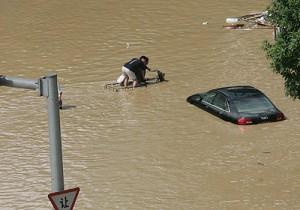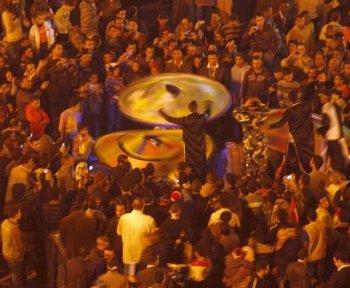An extraordinary rainstorm brought by Typhoon Longwang deluged Fuzhou city days ago, causing catastrophic losses. Afterward, net surfers criticized China’s state-run media for covering up facts of the natural disaster such as the death toll, the exact number of injured, and the extent of property loss.
According to reliable sources, on the second day following the catastrophe, an alarming number of armed policemen were sent to all areas of Fuzhou city to block relevant news; residents and media were forbidden to contact victims. The government and state-run media collaborated to obscure the facts.
Overseas reporters called the following agencies of Fujian province: Department of Public Security, Department of Water Resources, Ministry of Civil Affairs, Office of Flood Control, Ministry of Propaganda, Information Office, and the Headquarters of the Armed Police Force. Each of these governmental agencies claimed no understanding of the impact of the catastrophe and then asked the reporters to call the other agencies for more information.
State-run Media Covered up Catastrophic Losses
On October 3, China’s Xinhuanet published the following news from Fuzhou: As of today, it is estimated that 2,463,500 were affected by the natural disaster in eight metropolitan areas and 50 counties (cities and districts) in Fujian province, 537,000 of which were evacuated from the flooding areas. Three were killed by mountain torrents and landslides.
The next day, Xinhuanet reported: by 5 p.m., October 4, after more than a 40-hour rescue effort, the corpses of 50 armed policemen were found, with 36 still missing.
But locals told overseas media that the death toll was much higher. The training base of the Fuzhou Armed Police Force Command College was located in Shangjie town, Minhou county, about nine kilometers from Fuzhou city. Radio Free Asia reported that, after the flood, the whole training base had been swept away, with at least 200 missing.
Another local revealed that the flood left few alive at the training base, and that just over 100 were missing. The affected area is still blockaded.
Net Surfers stated that over 100 soldiers in Fuzhou were washed away by the mountain torrents, while the collapse of Dayi Reservoir in Minhou county caused at least 60 deaths, with numerous people missing. Corpses were scattered along the Shangfu railway, and more dead bodies were piled up under a bridge next to National Highway 324. Trucks were seen floating by, each carrying several corpses. Three- and four-story buildings collapsed instantly, while thousands of livestock were swept away by the floodwaters.
According to a villager in Qingkou town, Minhou county, Fuzhou city, there were at least 120 deaths in Dayi village alone, and those who survived the tragedy found themselves surrounded by thousands of dead, rotting pigs.
In other places, such as Luoyuan and Changle counties, the natural disaster also claimed lives. Particularly in Luoyuan county, many people were killed. In some remote mountainous areas, landslides occurred, while river levels were said to dramatically rise, causing more deaths. Residents in these areas suffered large losses. The entire Fuzhou city was flooded. Based on a conservative estimate, the death toll is at least 350.
A message sent by one net surfer reads: Fuzhou city in Fujian province was not the place directly hit by Typhoon Longwang. It was Weitou in Quanzhou city that suffered the full force of the typhoon. Fuzhou, hundreds of kilometers away from Weitou, was so seriously damaged. We dare not imagine the miserable state of Weitou.
State-run Media Blocked Relevant Information, Pretending that Everything was Well
Some net surfers revealed that on the second day following the catastrophe, an alarming number of armed policemen were sent to all parts of Fuzhou to block relevant news; neither locals nor media were allowed to contact the victims. The government and its state-run media collaborated with one another to obscure the facts.
On the fourth day following the natural disaster, Fujian authorities reported that 15 citizens had died and 11 were missing. Instead of reporting the full facts of the catastrophe, the media published many articles to convince people that everything was going well, said the net surfers.
The CCP Committee and the government of Fujian province released a news report claiming that, with the decisive strategies and detailed planning of the CCP Committee, all the government agencies were sufficiently organized to combat the natural disaster and thus effectively minimized damages and protected people and their property from harm.
Comparison between Reports of China’s Tragedy and Reports of America’s Tragedy
China’s state-run media provides elaborate details of overseas tragedies, but when it comes to any tragedy happening in China, few “negative” scenes can be found, said the net surfers.
In their efforts to cover up facts, Chinese authorities made no mention of the tragic losses in Fujian, Zhejiang, and Hainan provinces, which have been hit by typhoons over ten times this year. However, the one natural disaster in the U.S had been successively reported for a week.
Viewers who watched the 7 p.m. CCTV news program on October 3 saw no scenes of the flooding in Fuzhou city, but saw the reports of the hurricanes in the U.S. Reports of the U.S. hurricanes had been repeated almost around the clock.



